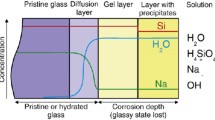Abstract
A new method for molecular dynamics (MD) modeling of the glass structure using a crystal structural template is proposed. The template is based on the unit cell of the crystalline phase, whose composition is qualitatively similar to the modeled glass. Using this approach and multistage MD simulation, the model of the spatial structure of grade E borosilicate glass, reproducing its physicochemical characteristics, is obtained. The proposed method enables to model the glass structure using classical MD methods with greater productivity and stability.

Similar content being viewed by others
REFERENCES
Christie, J., Ainsworth, R., Hernandez, S., and de Leeuw, N., Structures and properties of phosphate-based bioactive glasses from computer simulation: A review, J. Mater. Chem. B, 2017, vol. 5, pp. 5297–5306.
Cormack, A.N., Yuan, X., and Park, B., Molecular dynamics simulations of silicate glasses and melts, Glass Phys. Chem., 2001, vol. 27, pp. 28–36.
Liang, J.-J., Cygan, R., and Alam, T., Molecular dynamics simulation of the structure and properties of lithium phosphate glasses, J. Non-Cryst. Solids, 2000, vols. 263–264, pp. 167–179.
Jia, B., Li, M., Yan, X., Wang, Q., and He, S., Structure investigation of CaO-SiO2-Al2O3-Li2O by molecular dynamics simulation and Raman spectroscopy, J. Non-Cryst. Solids, 2019, vol. 526, p. 119695.
Hu, Y.-J., Zhao, G., Zhang, M., Bin, B., Rose, T.D., Zhao, Q., Zu, Q., Chen, Y., and Sun, X., Predicting densities and elastic moduli of SiO2 based glasses by machine learning, npj Comput. Mater., 2020, vol. 6, pp. 1–13.
Deng, B. and Harris, J.T., A novel approach to generate glass-ceramics samples for molecular dynamics simulations, Comput. Mater. Sci., 2021, vol. 186, p. 110008.
Hong, X. and Newville, M., Polyamorphism of GeO2 glass at high pressure, Phys. Status Solidi B, 2020, vol. 257, p. 2000052.
Brazhkin, V.V., Lyapin, A.G., and Trachenko, K., Atomistic modeling of multiple amorphous–amorphous transitions in SiO2 and GeO2 glasses at megabar pressures, Phys. Rev. B, 2011, vol. 83, p. 132103.
Tsuchiya, T., Yamanaka, T., and Matsui, M., Molecular dynamics study of pressure-induced transformation of quartz-type GeO2, Phys. Chem. Miner., 2000, vol. 27, pp. 149–155.
Kapoor, S., Goel, A., Tilocca, A., Dhuna, V., Bhatia, G., Dhuna, K., and Ferreira, J.M., Role of glass structure in defining the chemical dissolution behavior, bioactivity and antioxidant properties of zinc and strontium co-doped alkali-free phosphosilicate glasses, Acta Biomater., 2014, vol. 10, pp. 3264–3278.
Upadhyay, A., Sebeck, K., and Kieffer, J., Spectral mode assignment for binary silicate glasses using molecular dynamics simulations, J. Non-Cryst. Solids, 2012, vol. 358, pp. 3348–3354.
Chainikova, A., Orlova, L., Popovich, N., Lebedeva, Y., and Solncev, S., Functional composites based on glass/glass-ceramics matrixes and discrete fillers: Properties and possible applications, Aviat. Mater. Technol., 2014, vol. 0, pp. 52–58.
Wang, X., Xie, W., Ren, J., Zhu, J., Li, L.-Y., and Xing, F., Interfacial binding energy between calcium-silicate-hydrates and epoxy resin: A molecular dynamics study, Polymers, 2021, vol. 13, p. 1683.
Babaevskii, P.G., Napolniteli dlya polimernykh kompozitsionnykh materialov: Spravochnoe posobie (Fillers for Polymer Composite Materials, Reference Book), Moscow: Khimiya, 1981.
Mishnev, M., Korolev, A., Ekaterina, B., and Dmitrii, U., Effect of long-term thermal relaxation of epoxy binder on thermoelasticity of fiberglass plastics: Multiscale modeling and experiments, Polymers, 2022, vol. 14, p. 1712.
Maslov, V., Grozdov, A., and Kutepov, D., Methods of determining the composition of low-molecular weight epoxide diane resins, Polym. Sci. (USSR), 1982, vol. 24, pp. 2034–2039.
Vaitkus, A., Merkys, A., and Grazulis, S., Validation of the crystallography open database using the crystallographic information framework, J. Appl. Crystallogr., 2021, vol. 54, pp. 661–672.
Abraham, M.J., Murtola, T., Schulz, R., Pall, S., Smith, J.C., Hess, B., and Lindahl, E., GROMACS: High performance molecular simulations through multi-level parallelism from laptops to supercomputers, SoftwareX, 2015, vols. 1–2, pp. 19–25.
Makarov, G.I., Shilkova, K.S., Shunailov, A.V., Pavlov, P.V., and Makarova, T.M., A set of self-consistent Lennard-Jones potential parameters for molecular dynamics simulation of borosilicate glasses, Glass Phys. Chem., 2023, vol. 49, in press.
Bussi, G., Donadio, D., and Parrinello, M., Canonical sampling through velocity rescaling, J. Chem. Phys., 2007, vol. 126, pp. 014107–014106.
Berendsen, H., Postma, J., van Gunsteren, W., Di Nola, A., and Haak, J., Molecular dynamics with coupling to an external bath, J. Chem. Phys., 1984, vol. 81, pp. 3684–3690.
Darden, T., York, D., and Pedersen, L., Particle mesh Ewald: An Nlog(N) method for Ewald sums in large systems, J. Chem. Phys., 1993, vol. 98, pp. 10089–10092.
Wennberg, C.L., Murtola, T., Hess, B., and Lindahl, E., Lennard-Jones lattice summation in bilayer simulations has critical effects on surface tension and lipid properties, J. Chem. Theory Comput., 2013, vol. 9, pp. 3527–3537.
Gale, J. and Rohl, A., The General Utility Lattice Program (GULP), Mol. Simul., 2003, vol. 29, pp. 291–341.
Funding
This study was supported by a grant from the Russian Ministry of Science and Higher Education (FENU 2023-0012).
Author information
Authors and Affiliations
Corresponding author
Ethics declarations
The authors of this work declare that they have no conflicts of interest.
Additional information
Publisher’s Note.
Pleiades Publishing remains neutral with regard to jurisdictional claims in published maps and institutional affiliations.
Rights and permissions
About this article
Cite this article
Makarov, G.I., Makarova, T.M. Molecular Dynamics Modeling of the Grade E Borosilicate Glass Structure Using a Crystal Structural Template. Glass Phys Chem 49, 635–641 (2023). https://doi.org/10.1134/S1087659623600631
Received:
Revised:
Accepted:
Published:
Issue Date:
DOI: https://doi.org/10.1134/S1087659623600631




